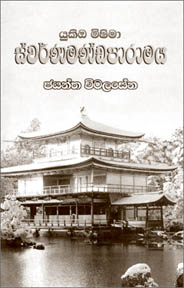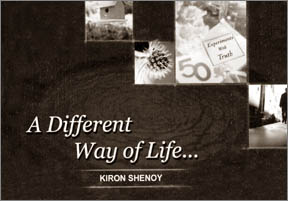Story behind the story

fire at the Golden Pavillion:
by Deepal Warnakulasuriya
Title: Kinkakuji
(Swarnamandaparamaya)
Author: Yukio Mishima
Translated by Jayantha Wimalasena
Published by: Visidunu Publishers
 Highly appreciating Japanese author Yukio Mishima's novel: Kinkakuji
(the Temple of the Golden Pavillion) which was published in 1956
Jayantha Wimalasena has translated the book into Sinhala as 'Swarnamandaparamaya'.
The novel is based on the burning of Kyoto's Kinkakuji Temple by a
Buddhist acolyte in 1950. Highly appreciating Japanese author Yukio Mishima's novel: Kinkakuji
(the Temple of the Golden Pavillion) which was published in 1956
Jayantha Wimalasena has translated the book into Sinhala as 'Swarnamandaparamaya'.
The novel is based on the burning of Kyoto's Kinkakuji Temple by a
Buddhist acolyte in 1950.
Swarnamandaparamaya has been written using the English translation of
the original book 'The Temple of the Golden Pavillion' by Evan Morris in
1959. This is considered as the best of work from over 200 of Mishima's
works.
His name has been considered thrice for the Nobel Prize on Utarature
and Kinkkaku has been awarded as the best novel in 1957 by the Yomura
newspaper company. The Golden Pavillion Temple was a Natural Monument
which had been spared by the American bombers during the second World
War.
The story is narrated by a young man who burns the temple, and
possesses an ugly face as well as a stutter. He also recounts his
obsession with beauty and the growth of his urge to destroy it.
In another way he can also be identified as a person who has lost his
way between tradition and modernity. The novel is basically capable of
attracting the reader by its vision which covers the old Japan and the
modernised Japan.
Mishima has done an extraordinary literary work based on a real
incident. His creativity emerges through the development of the
protagonist in the novel. The novel begins from Mizoguchis childhood,
his father keeps telling him about the beauty and the pride of the
Golden Pavillion.
His father being a poor village clergyman who attends to the
religious functions decides to send his son to the Golden Pavillion
temple which is run by a friend. He wants to establish his son as a
priest there.
Mishimas uses his psychological and social knowledge to describe and
explore Mogoguchi's life in the Golden Pavillion temple. Author friend
reasons and explains why he (migoguchi) hates the chief prelate in the
temple.
Why he does not like the beauty of the Golden temple which is
appreciated by all Japanese and foreigners. He neglects his education,
spends money on unnecessary things and the novel ends with the burning
of the temple.
We see in the Sinhala translation too the author's ability of telling
a story arousing the readers' curiosity. This book is a good example of
his ability to read others minds.
The translator Jayantha Wimalasena who had learnt Sinhala, Pali,
Sanskrit, and English languages, retired from the public service in 1986
after serving for 30 years in the Sinhala Dictionary Editorial Board.
When he was retiring he was the Deputy Editor there.
He has also translated two Japanese novels, a collection of short
stories, and a collection of essays on Japanese culture. In 1965, 1981
and 1991, he was awarded the state literary awards for his translation
works.
In 'Swarnamandaparamaya' he uses, instead of simple words he used the
written language with complex words. The sentences are also very long.
But, the way he reveals the story keeps the reader bound to the book to
the very end. The most interesting feature of the book is that it
reveals a different side of the Buddhist temples in Japan and the
lifestyles attached to them.
He selects one character which is worst suitable for the novel and
handles the character with flexibility. The novel also includes one of
Mishima's most memorable characters, the hero's club-pointed, deeply
cynical friend Kashiwagi who gives his own highly individual twists to
various Zen stories.
As Mishima explains, the Golden Pavillion, temple is one of the
nicest places to watch and to calmly walk through in Kyotho. Almost two
years back, when I was walking through the leafy lanes of the Golden
Pavillion temple premises, I never expected such a beautiful and
interesting story behind the temple.
I remember my guide, the JIJI press English Editor Hidetoshi Sakai
telling me that the temple was burnt once by an acolyte and didn't want
him to continue the story. I wanted only to entertain the charming
surroundings of the temple as it was such a nice place.
But now Jayantha Wimalasena has revealed the story of the Golden
Pavillion temple through Swarnamandaparamaya. Here is a book that should
not merely be kept on your bookshelf but be read and re-read.
A different way of life
Title: A different way of life
Author: Kiron Shenoy
Published by: Veekay, International Publication, Sri Lanka.
 Our thoughts influence our physical, emotional and physiological
activities which can force us to determine our future. This was said to
me by one of a business man several years ago when I met him at a
meeting. Today the Pan Asia Group of Companies Group Director, Kiron
Shenoy has transferred his words into a literary work: "A different way
of life". Our thoughts influence our physical, emotional and physiological
activities which can force us to determine our future. This was said to
me by one of a business man several years ago when I met him at a
meeting. Today the Pan Asia Group of Companies Group Director, Kiron
Shenoy has transferred his words into a literary work: "A different way
of life".
The categorisation of the book is very difficult as it is a novel way
of presenting some encouraging and positive thinking ideas on timely
topics; life, of friends and ideology, marriage, etc.
The book is very small in size and only a half of a normal size of a
book. But throughout the 80 pages he enduces his readers to think
creatively and positively while looking at life very simply but
confidently. He provides a sub-title for the book as "50 years of my
experiments with truth". He also introduces the book "more on the lines
of self-help development."
The book is for easy reading and is interesting to read. The language
is very simple and the message is given directly. Sometimes, the ideas
are psychological. eg: "Be a radical, Be a rebel But don't die for an
idea or a thought Change the system, If you can, But follow it if you
cannot" And, in another place he says,
"Keep yourself busy, Don't get involved in any place If you can't
participate or contribute in its activities"
In a scope, the book offers you, in equal and more measure, helpful
insights into living your life well. The book is also focused on reality
as it is thoroughly practical. At any time, when you go through a page
it will give you something to guide you in your life.
The book is simple and suffused with wit and practical wisdom and
would offer you helpful insights from the fundamental truths of everyday
life. According to Kiron the big question is how to harness the power of
your mental muscles. He says the answer is within you and also asks you
to try with a good, self-help book.
Bimsath Warnakulasuriya
|
